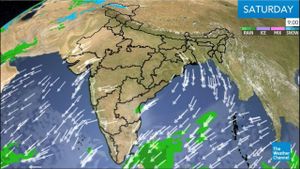A remarkable piece of prehistoric fossilized vomit has emerged as a significant find for scientists studying ancient ecosystems. Discovered by local fossil hunter Peter Bennicke at the UNESCO-listed site of Stevns Klint, located on the eastern coast of Denmark, this 66-million-year-old fossil provides pivotal insights about food chains from the late Cretaceous period, when dinosaurs were still roaming the Earth.
Bennicke stumbled upon the unusual fragments during his explorations along the 15-kilometer-long fossil-rich cliffs. Initially not recognizing their significance, he soon realized he had come across pieces of regurgitated sea lily—a type of underwater organism closely related to species like starfish and sea urchins. After gathering the fragments, he turned them over to the Museum of East Zealand for examination.
Upon evaluation, the museum’s team confirmed the vomit’s adventurous timeline, placing it firmly at the end of the Cretaceous, about 66 million years ago. This era is notable not only for the dominance of dinosaurs but also for the diverse marine life inhabiting the oceans. The findings shaped up the paleontological narrative, connecting the dots between ancient feeding habits and ecosystem interactions.
Palaeontologist Jesper Milàn, who served as the museum curator and led the investigation of the fossil, remarked, "It is truly an unusual find." He elaborated on why this fossil is particularly informative: "Sea lilies are not a particularly nutritious diet, as they mainly consist of calcareous plates held together by very few soft parts." The vomit, likely originating from a type of fish, implies this ancient creature consumed the sea lilies and later regurgitated their skeletal remains.
Through this fascinating lens, scientists gain new knowledge about predator-prey relationships and the intricacies of the food chains within the late Cretaceous sea. Milàn emphasized the importance of such findings: "Such a find provides important new knowledge about the relationship between predators and prey and the food chains in the Cretaceous sea."
This discovery has broader significance as well. Understanding how ancient creatures like fish interacted with their ecosystems can offer valuable parallels to modern-day marine biology and ecology. By examining what types of organisms were consumed and how they fit within the larger food web, researchers can start piecing together what the world looked like during those prehistoric times.
Rock formations and fossil finds like those at Stevns Klint continue to yield treasures for researchers. They serve as portals to the past, allowing scientists to visualize complex interactions among species long before humans ever walked the planet.
Discoveries like Bennicke's fossilized find not only rejuvenate interest and curiosity about marine history but remind us how much more there is to learn about the Earth’s ancient ecosystems. Every piece recovered from the ocean floor or rock layers scratches the surface of our planet’s immense historical narrative, painting increasingly detailed portraits of life on Earth as it once was.



